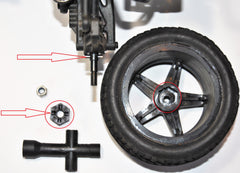GOBI FAQ
 |
|
LiteHawk GOBI Features:
|
|
LiteHawk R/C Car and Truck Terms 101 Transmitter: The hand-held radio unit that sends throttle and steering inputs to your model. Also known as the radio or controller. Servo: Small motor unit in your model that operates the steering mechanism. ESC: The Electronic Speed Control provides digital proportional throttle control to the model’s motor based upon your throttle input on the radio. |
|
LiteHawk GOBI - NIMH Battery and Charger Instructions:
During charging:
|
|
|
LiteHawk GOBI - Battery Installation
-Pass the battery connector through the hole located in the bottom of the battery compartment, out towards the ESC.
- Close the battery compartment door and slide the lock bar back into place. Secure by re-installing the clip. Connect the Battery to the ESC. Don’t force it, it only goes one way! Remount your GOBI Body and you are ready for the road. |
|
Starting your GOBI -Plug in your Battery, then turn on the Power switch on the Radio, it will start blinking green and red. -Then turn on the little red switch on the ESC. A red LED light will start blinking in the ESC. and if your wheels where turned to one side, they should snap to the center. The vehicle is basically bound to the radio now.. just move any control and the lights will stop blinking in the ESC and remain solid. The Radio control will now be a solid Green. |
|
LiteHawk GOBI Wheel Removal


|
|
LiteHawk Gobi - Shock Removal. Front and Rear.





|
|
LiteHawk GOBI Front C-Hubs, Steering Knuckle, and Axle.

|
|
Upper and Lower Front Suspension Arms
|
|
Shock Tower with Lower Body Mount Assembly, and The Steering Assembly.


|
|
Servo Access.
|
|
Rear Axle Assembly, Rear Lower Suspension Arm.
|
|
Rear Gear Box- Differential, Spur Gears, Motor, Pinion Gear.
|
|
Rear Shock Tower
|








































